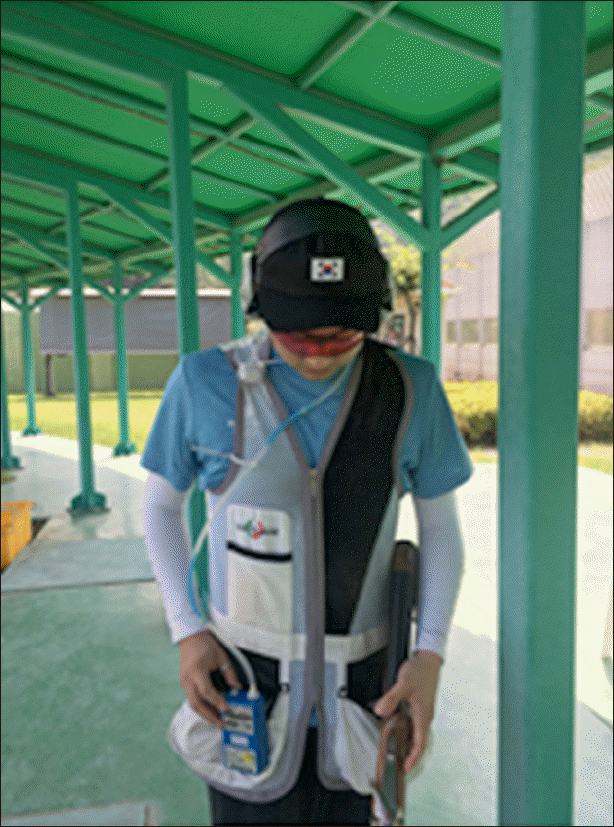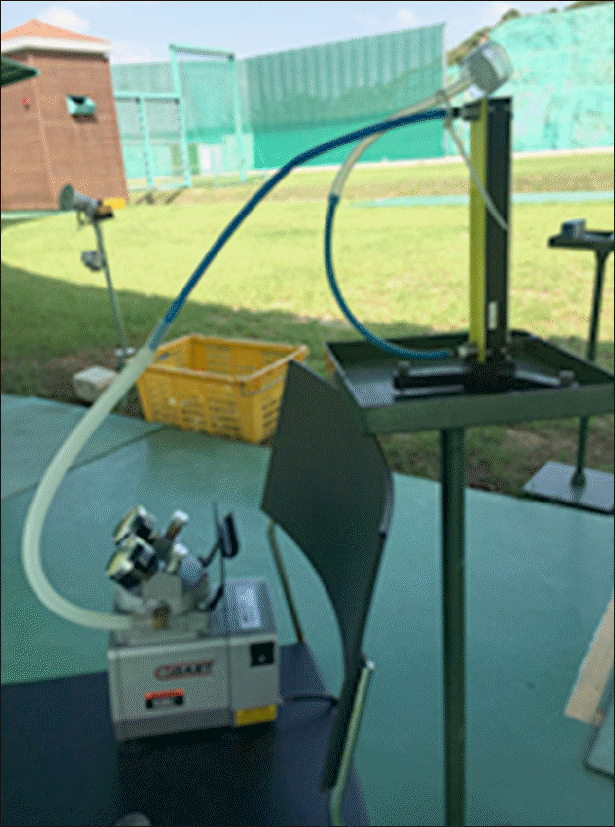Abstract
Purpose
This study was conducted to investigate the levels of heavy metals and self-rated health status of the national clay shooting athletes.
Methods
Fourteen subjects’ blood lead level and index of liver damage (aspartate aminotransferase, alanine aminotransferase, and γ-glutamyl transferase) were measured. Heavy metal content in training environment was measured by collecting the buckshot fume. In addition, subjects completed a questionnaire assessing self-rated health status (Todai Health Index).
Results
Antimony and lead were detected much more than other heavy metals in the air of the shooting range. The average blood lead level of 14 subjects was significantly higher than the upper limit of normal Korean adults. Blood lead level of male is significantly higher than female and training frequency and the total training time per week were positively correlated to the blood lead level. In the result of survey on self-rated health, the higher the blood lead level, the lower the score of the common subjective physical symptoms. By age, the younger the subjects are, the higher the score of the common subjective symptoms.
References
1. Park SJ. Analysis of the factors influencing national shooting athletes' performance [dissertation]. Seoul: Sejong University;2007.
2. Gelberg KH, Depersis R. Lead exposure among target shooters. Arch Environ Occup Health. 2009; 64:115–20.

3. Cho IH, Lee DJ, Jang GS. Evaluation of cognition and perceived health exposed indoor shooting range in pistol players. Sport Sci. 2017; 34:9–15.
4. Wolten GM, Nesbitt RS. On the mechanism of gunshot residue particle formation. J Forensic Sci. 1980; 25:533–45.

5. Brozek-Mucha Z. Chemical and morphological study of gunshot residue persisting on the shooter by means of scanning electron microscopy and energy dispersive X-ray spectrometry. Microsc Microanal. 2011; 17:972–82.

6. Demmeler M, Nowak D, Schierl R. High blood lead levels in recreational indoor-shooters. Int Arch Occup Environ Health. 2009; 82:539–42.

7. Park S, Bae B, Kim M, Chang Y. Distribution and behavior of mixed contaminants, explosives and heavy metals, at a small scale military shooting range. J Korean Soc Water Qual. 2008; 24:523–32.
8. Cao X, Ma LQ, Chen M, Hardison DW, Harris WG. Lead transformation and distribution in the soils of shooting ranges in Florida, USA. Sci Total Environ. 2003; 307:179–89.

9. Islam MN, Nguyen XP, Jung HY, Park JH. Chemical speciation and quantitative evaluation of heavy metal pollution hazards in two army shooting range backstop soils. Bull Environ Contam Toxicol. 2016; 96:179–85.

10. Sanderson P, Naidu R, Bolan N. Ecotoxicity of chemically stabilized metal(loid)s in shooting range soils. Ecotoxicol Environ Saf. 2014; 100:201–8.
11. Lach K, Steer B, Gorbunov B, Micka V, Muir RB. Evaluation of exposure to airborne heavy metals at gun shooting ranges. Ann Occup Hyg. 2015; 59:307–23.
12. Jung WG, Im IS, Seo JG. A study of indoor air pollution for ssireum stadia and physical symptoms of which players is conscious. Korean J Phys Educ. 1999; 38:603–16.
13. Green Cross Laboratories. Pb reference range, cutoff verification data. Yongin: Green Cross Laboratories;2016.
14. Korea Occupational Safety and Health Agency. Health care guidelines for workers who exposed to lead and its compounds. Ulsan: Korea Occupational Safety and Health Agency;2013.
15. Martin D, Glass TA, Bandeen-Roche K, Todd AC, Shi W, Schwartz BS. Association of blood lead and tibia lead with blood pressure and hypertension in a community sample of older adults. Am J Epidemiol. 2006; 163:467–78.

16. Hu H, Shih R, Rothenberg S, Schwartz BS. The epidemiology of lead toxicity in adults: measuring dose and consideration of other methodologic issues. Environ Health Perspect. 2007; 115:455–62.

17. Lee KH. A study of Pb level in candidate shooters. J Sport Leis Stud. 2001; 16:621–28.
18. Gilbert SG, Weiss B. A rationale for lowering the blood lead action level from 10 to 2 microg/dL. Neurotoxicology. 2006; 27:693–701.
19. National Institute of Food and Drug Safety Evaluation. Toxicity information. Cheongju: National Institute of Food and Drug Safety Evaluation;2008.
20. Miyauchi H, Kumihashi M, Shibayama T. The contribution of trace elements from smokeless powder to post firing residues. J Forensic Sci. 1998; 43:90–6.

21. Rosenberg MB, Dockery CR. Determining the lifetime of detectable amounts of gunshot residue on the hands of a shooter using laser-induced breakdown spectroscopy. Appl Spectrosc. 2008; 62:1238–41.

22. Albahary C. Lead and hemopoiesis: the mechanism and consequences of the erythropathy of occupational lead poisoning. Am J Med. 1972; 52:367–78.
23. Scheuhammer AM. The chronic toxicity of aluminium, cadmium, mercury, and lead in birds: a review. Environ Pollut. 1987; 46:263–95.

24. Burger J, Reilly SM, Gochfeld M. Comparison of lead levels in bone, feathers, and liver of herring gull chicks (Larus argentatus). Pharmacol Biochem Behav. 1992; 41:289–93.

25. Markiewicz-Gorka I, Januszewska L, Michalak A, et al. Effects of chronic exposure to lead, cadmium, and manganese mixtures on oxidative stress in rat liver and heart. Arh Hig Rada Toksikol. 2015; 66:51–62.
26. Seo JY, Kim JR, Yoo BW. Interpretation of liver function test. Korean J Fam Pract. 2012; 2:207–13.
27. Jeong YJ. Assessment of health status by Todai Health Index of medical technologist in Inchon [dissertation]. Seoul: Gachon University;2007.
28. Lee HE. A study on the determinants of quality of life of the dental technician [dissertation]. Daejeon: Chungnam National University;2013.
Table 1.
Demographic characteristics
| Variable | No. (%) |
|---|---|
| Sex | |
| Male | 9 (64.29) |
| Female | 5 (35.71) |
| Age (yr) | |
| 20−30 | 7 (50) |
| 31−40 | 4 (28.57) |
| 41−50 | 3 (21.43) |
Table 2.
Total career duration and training pattern
Table 3.
Fume component and concentration of clay shooting range
| Component | NAAQS | m/z |
Personal shooting air sampler* |
Group shooting air sampler† |
||
|---|---|---|---|---|---|---|
| ICP-MS (μL/L) | Conc (μg/m3) | ICP-MS (μL/L) | Conc (μg/m3) | |||
| B | – | 11 | 0.56 | 0.60 | 0.43 | 0.12 |
| C | – | 52 | 17.5 | 18.7 | 25.7 | 7.14 |
| Mn | – | 55 | 1.13 | 1.21 | 0.15 | 0.04 |
| Sn | – | 118 | 2.86 | 3.06 | 0.28 | 0.08 |
| Sb | – | 121 | 360 | 385 | 51.2 | 14.2 |
| Ba | – | 138 | 32.3 | 34.5 | 67.7 | 18.8 |
| Pb | 0.15 | 208 | 273 | 292 | 67.2 | 18.7 |
Table 4.
Blood lead level difference according to sexuality and training frequency
| Variable | Mean±SD | p-value | Post-hoc analysis |
|---|---|---|---|
| Sex | 0.042* | – | |
| Male (n=9) | 5.1±1.64 | ||
| Female (n=5) | 3.6±0.77 | ||
| Training frequency | 0.007* | 4,5<6 | |
| 4 Times (n=1) | 2.9±0.0 | ||
| 5 Times (n=7) | 3.64±0.55 | ||
| 6 Times (n=6) | 5.82±1.55 |
Table 5.
AST, ALT and γ-GT differences according to sexuality
| Variable | Mean±SD | p-value |
|---|---|---|
| AST | 0.112 | |
| Male (n=9) | 27.44±10.43 | |
| Female (n=5) | 21.60±1.36 | |
| ALT | 0.012* | |
| Male (n=9) | 33.78±28.82 | |
| Female (n=5) | 14.00±4.61 | |
| γ-GT | 0.001* | |
| Male (n=9) | 38.00±18.35 | |
| Female (n=5) | 17.60±18.91 |
Table 6.
Interrelationship between blood lead conc (μg/dL) and THI, total career duration (year) and THI, and age (year) and THI
| Category B |
Blood lead conc and THI |
Total career duration and THI |
Age and THI |
|||
|---|---|---|---|---|---|---|
| Correlation coefficient | p-value | Correlation coefficient | p-value | Correlation coefficient | p-value | |
| Multiple subjective symptoms | −0.536* | 0.048 | −0.323 | 0.241 | −0.651† | 0.009 |
| Respiratory | −0.487 | 0.077 | −0.271 | 0.329 | −0.360 | 0.187 |
| Eyes and skin | −0.190 | 0.515 | −0.129 | 0.647 | −0.281 | 0.310 |
| Mouth and anus | −0.349 | 0.222 | −0.443 | 0.098 | −0.543* | 0.036 |
| Digestive | −0.398 | 0.158 | −0.127 | 0.651 | −0.132 | 0.640 |
| Impulsiveness | 0.104 | 0.723 | −0.227 | 0.416 | −0.385 | 0.156 |
| Lie scale | 0.316 | 0.271 | 0.770† | 0.001 | 0.806† | 0.000 |
| Mental irritability | −0.381 | 0.179 | −0.315 | 0.253 | −0.579* | 0.024 |
| Depression | −0.430 | 0.125 | −0.137 | 0.627 | −0.562* | 0.029 |
| Aggressiveness | 0.346 | 0.225 | 0.389 | 0.152 | 0.607* | 0.016 |
| Nervousness | 0.398 | 0.158 | 0.112 | 0.692 | 0.070 | 0.805 |
| Irregular life | −0.439 | 0.117 | −0.228 | 0.414 | −0.410 | 0.129 |




 PDF
PDF ePub
ePub Citation
Citation Print
Print




 XML Download
XML Download